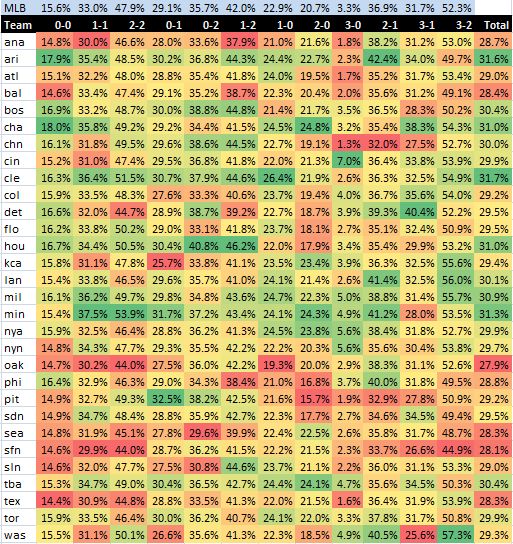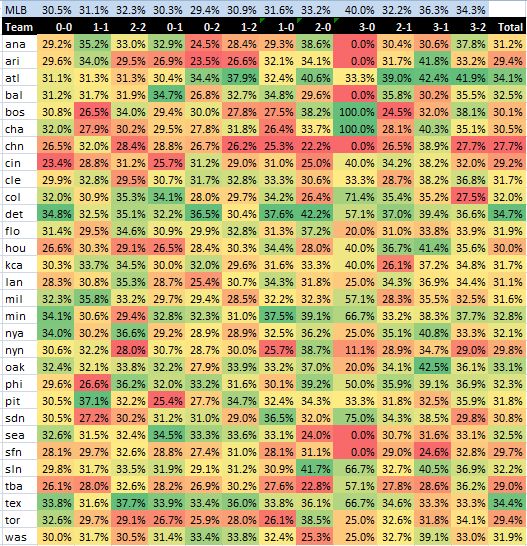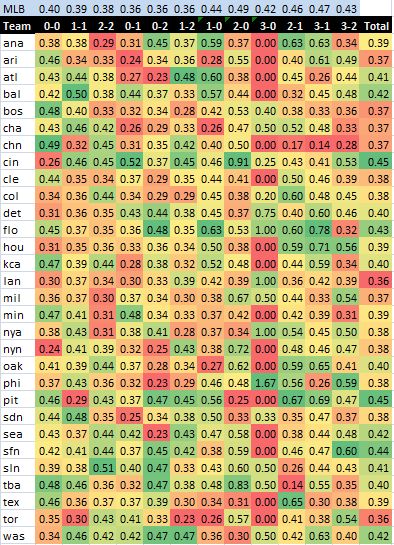Way back in 2008 I started to run a series using pitch f/x data to look at strike throwing tendencies. Sadly this is the slowest moving “series” of posts ever. Nonetheless, it’s time for part 3 where we look at how teams do when they get strikes outside of the zone. For this exercise I’m not looking at those generous calls off the corners, but for those strikes when hitters go fishing.
The first table we turn to is the fish rate, or the percent of pitches outside of the strike zone that hitters swung at. This is presented by count. As for the pretty shading, red are lower numbers and green are higher numbers.

In what is somewhat of a surprise, it isn’t the 0-2 or 1-2 counts that get the most fishing. That occurs with a full count or a 2-2 count. My guess is that the pitchers are so intent on wasting a pitch, that it isn’t even tempting enough to swing at. The result is a truly wasted pitch. Maybe it sets something up, maybe it doesn’t (that would actually make for an interesting study – set-up pitches).
From the Tigers perspective, it is a little odd that they would get a relatively high chase rate on 0-2 but a really low one on 1-2. As for the other staff I’m most interested in, the Twins had hitters fishing on pretty much every count. My inclination is that the Twins staff has control that is so good, that even when they miss, they aren’t missing by much.
Moving on, the next chart shows the rate at which fished pitches are put in play, as opposed to just resulting in strikes.

On the whole, there isn’t a whole lot of variation by count. You can effectively throw out the 3-0 rate because only 3.3% of pitches outside of the zone on that count get swung at. The 0-2 whole sees the least success which isn’t surprising. The pitch probably has the least chance of being close to the plate, so if hitters are swinging their chances aren’t that great. And in the case of a 3-1 count it would seem that hitters may be looking for a pitch in a specific spot and would be willing to swing even if it wasn’t a strike if it was in their happy zone. Either that or they get so amped up for a fastball they swing no matter where it’s at.
Taking a Tigers centric focus, hitters didn’t seem to have a hard time putting the ball in play even when it was out of the zone. I don’t really no what to make of this.
Finally, it’s all well and good to get hitters to chase pitches. It would seem to work in the pitchers favor if they don’t have to throw the ball over the plate. But what do the results show? The table below is bases per fished pitch in play, of BPFPIP. I’m sure that acronym will catch on.

The Dodgers, Cubs, and Blue Jays appeared to have the most success in limiting the oppositions success when they went out of the strike zone. What I don’t know is if that is a repeatable skill. But what does appear to be true is that getting hitters to fish is beneficial on the whole. The correlation between fish rate and balls per fished… is -.49 meaning that there is a relationship and that as fishing goes up, success goes down.
Now these numbers aren’t park adjusted at all and this is a fairly crude (okay really crude) analysis so take it with a grain of salt. Also the numbers aren’t the least bit surprising, but in my defense I didn’t know that before I started the analysis and it would seem a waste to throw it away.
One thought on “Not pounding the zone”
Comments are closed.